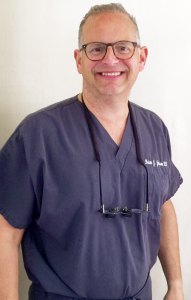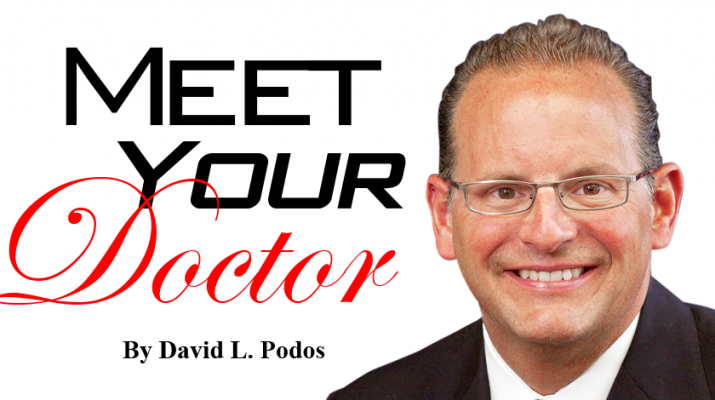Dr. Brian Jackson is an implant surgeon and reconstructive dentist who has been surgically placing and restoring dental implants for over 20 years. He practices at Slavin-Jackson-Burns DDS Family Dentistry and Dental Health in Utica.
By David L. Podos
 Q.: How long have you been practicing dentistry?
Q.: How long have you been practicing dentistry?
A.: It’s been well over 20 years. I received my dental degree in 1989 from the University of Buffalo, then spent a year doing a general dental practice residency program. I practiced for a few years then was involved in a part-time program at New York University that was focused on implant dentistry.
Q.: What is an implant?
A.: An implant is really nothing more than a tiny titanium screw that generally serves two purposes. It either can be used to retain or hold a denture in place, which is known as an over-denture, or it can be used to serve as a root of a tooth where you can put a crown on the tooth. It can be used to have crowns or bridges permanently cemented in or can be used as a retentive feature for dentures.
Q.: When did you start incorporating implants into your practice and why?
A.: My first surgical placement of a dental implant was in 1993. For me, there are two reasons why I began doing more implants. First, I always liked the surgical aspect of dentistry. I also did not want to give up the cosmetic side of dentistry, so with implants, I could do both.
Q.: What do your patients say about implants, and what is the biggest benefit of them?
A.: From a biological point of view, the biggest advantage of doing dental implants is that it prevents bone resorption. So, if you remove teeth, in time the bone resorbs away. There is no reason for the bone to be there because the tooth is gone.
By placing a dental implant into the patient, you maintain the bone. The thing that patients often ask is, “Why did I wait so long to do it?” I have yet met a patient that regretted having an implant procedure.
They also say they didn’t realize how simple it would be to have an implant, and how easy it was going to go. They didn’t have to be put to sleep or have to take narcotics. So, for most patients, they say it was a pretty easy, seamless procedure. They are healthier, more confident, and they don’t get cavities, because you cannot get a cavity on a dental implant.
Q.: Technology is changing all the time. Regarding dentistry and specifically implants, where do you see things going in the world of implants?
A.: Because we understand the science behind implants, we are going to see the manufacturers change design and surface structures and we will combine that with computer-aided design. Procedures will become more minimally invasive.
Designs will virtually be done on the computer. Not only will we be able to do enhanced treatment times, we are going to reduce the time things need to be done.
Also, because of CBC technology (a cone-beamed computed tomography scan) that is a very specific CT scan of the jawbone, it gives us information on the thickness of a patient’s jawbone, so it adds a further dimension for treatment. What that allows us to do is to be very specific on the placement of the implant. It allows us to know very clearly where nerves and blood vessels are, so we are much more efficient working surgically. We can also design our final prosthesis on the computer so we have an accurate picture of the final product.
Q.: I understand that you lecture nationally as well as internationally to dentists regarding implants.
A.: I didn’t start speaking until I got published in peer-reviewed dental journals. But yes, I do speak to dentists nationally and internationally on implants. I am one of only 400 board-certified implant dentists worldwide, and I take that very seriously because it required a great deal of education and training.
Being able to do both the surgical and restorative aspects of implants has allowed me to take the body of evidence from researchers from all over the world, put it together, and consolidate procedures, which then I can speak about on a national as well as an international level.
I also speak about two procedures that are unique to me that I use in my practice — Synergy 2 and Synergy 2 complete.
These procedures drastically cut down on the time a patient needs to come in, regardless if I am doing a single-tooth implant replacement, a full-arch rehabilitation, or replacing many or all of a patient’s teeth.
Lifelines
Hometown: New Hartford
Education: Dental degree, University of Buffalo School of Dental Medicine; dental practice residency program, St. Luke’s-Memorial Hospital Center, Utica; implant program, New York University College of Dentistry
Affiliations: Diplomate, American Board of Oral Implantology-Implant Dentistry; honored fellow, American Academy of Implant Dentistry; member, American Dental Association
Personal: Married, two sons and a daughter
Hobbies: Travel; golf

